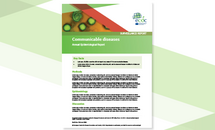Seasonal influenza, Annual Epidemiological Report for 2018–2019
During the 2017–2018 season, influenza activity started in week 49/2018, peaked in week 7/2019 and returned to baseline levels in week 17/2019. Influenza viruses circulated at high levels between weeks 52/2018 and 12/2019.
Executive summary
Influenza activity started in week 49/2018, peaked in week 7/2019 and returned to baseline levels in week 17/2019. Influenza viruses circulated at high levels between weeks 52/2018 and 12/2019.
The vast majority of influenza viruses detected were type A. Both influenza A subtypes, A(H1N1)pdm09 and A(H3N2), co-circulated and different distributions of A subtypes were observed among countries.
Very low numbers of type B viruses and both influenza B lineages, B/Yamagata and B/Victoria, were detected. ICU cases were mainly aged 65 years and older, but there was a substantial number of hospitalisations in persons aged 40–64 years. Most hospitalisations were due to influenza A infections.
Excess mortality from all causes was reported by the majority of 22 reporting countries and was mainly observed in people aged 65 years and older but also in the 15–64 year age group. The vast majority of influenza viruses tested were susceptible to neuraminidase inhibitors.
Corrigendum: On 2 December 2019, corrections were made to the data presented in the report. Please see the document for details.
Download

More on seasonal influenza
Infographic: Influenza in Europe, Season 2018-2019
Influenza virus characterisation, September 2019
This is the tenth and final report for the 2018–19 influenza season. As of week 39/2019, 205 947 influenza detections across the WHO European Region had been reported; 99% type A viruses, with A(H1N1)pdm09 prevailing over A(H3N2), and 1.2% type B viruses, with 86 of 165 (52%) ascribed to a lineage being B/Yamagata.



